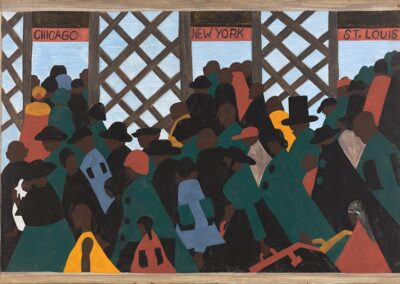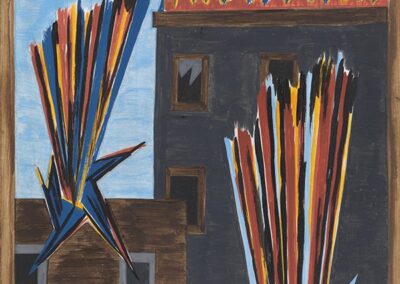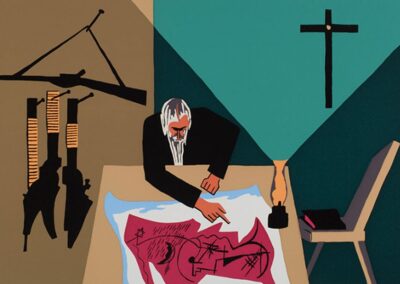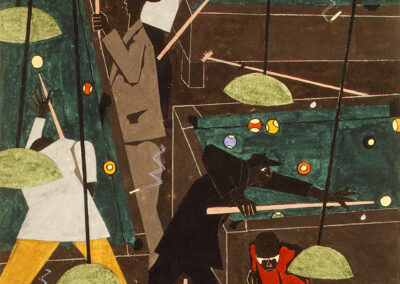Our next Artist You Need To Know is among one of the most significant American artists of the twentieth-century, whose work was intensely personal but also stands as a fine historical narrative. Jacob Lawrence (1917 – 2000) was an American painter known for his portrayal of African-American historical subjects and contemporary life.
Lawrence was as skilled with words, as with his illustrations, and offered the following about his own artwork : “I am part of the Black community, so I am the Black community speaking.”
He was born in Atlantic City, New Jersey, where his parents had migrated from the rural south. When he was 13, he and his siblings moved to New York City: he was introduced to art shortly after that when their mother enrolled him in after-school classes at an arts and crafts settlement house in Harlem, called Utopia Children’s Center. After dropping out of school at 16, Lawrence worked in a laundromat and a printing plant. He continued with art, attending classes at the Harlem Art Workshop, taught by the noted African-American artist Charles Alston. Alston urged him to attend the Harlem Community Art Center, led by the sculptor Augusta Savage. Savage secured a scholarship to the American Artists School for Lawrence and a paid position with the Works Progress Administration, established during the Great Depression by the administration of President Franklin D. Roosevelt. Lawrence continued his studies as well, working with Alston and Henry Bannarn, another Harlem Renaissance artist, in the Alston-Bannarn workshop. He also studied at Harlem Art Workshop in New York in 1937. Harlem provided crucial training for the majority of Black artists in the United States. Lawrence was one of the first artists trained in and by the African-American community in Harlem.
At the age of 23 Lawrence gained national recognition with his 60-panel The Migration Series, which depicted the Great Migration of African Americans from the rural South to the urban North. The series was purchased jointly by the Phillips Collection in Washington, D.C., and the Museum of Modern Art (MoMA) in New York.
The images shared above are from The Migration series (1940 – 41), and much more about these works – including commentary by Jacob Lawrence himself – can be enjoyed here.
Lawrence blended aspects of social realism, abstraction, a minimalist sense of composition and a bold use of color to “create compelling stories of African American experiences and the history of the United States. Drawing on his own life and what he witnessed in his Harlem neighborhood of New York City, Lawrence strove to communicate human struggles and aspirations that resonated with diverse viewers. Coming to artistic maturity during the waning of the Harlem Renaissance and the waxing of Abstract Expressionism, Lawrence charted a unique path, telling poignant stories of migration, war, and mental illness, among others, and would become a powerful influence for younger African American and African artists. While often drawing on the specific experiences of African Americans, Lawrence’s long-running and prolific career produced an oeuvre that speaks dramatically, graphically, and movingly to viewers of all colors and persuasions.” (from here)
From The Metropolitan Museum of Art: “Lawrence steeped himself in historical research. In 1937, he painted a series of forty-one panels, The Life of Toussaint L’Ouverture (Amistad Research Center, Tulane University, Aaron Douglas Collection), depicting seminal moments in the life of this leader of the Haitian independence movement. Other series focused on a diverse array of major historical figures in the antislavery movement, including Frederick Douglass, Harriet Tubman, and John Brown.”
Even after he turned from history painting to the daily life of Harlem as his subject in 1942, Lawrence investigated the most significant social issues of his community: family values, the plight of the poor, and especially the role of the manual laborer. Again, Lawrence’s own words resonate as well as his images: “This is my genre…the happiness, tragedies, and the sorrows of mankind as realized in the teeming black ghetto.”
The images below are from the The Life of Toussaint L’Ouverture (a more detailed accounting of these works can be seen here).
Lawrence’s works are in the permanent collections of numerous museums, including the British Museum, the Metropolitan Museum of Art, the Smithsonian American Art Museum, the Museum of Modern Art, the Whitney Museum, the Phillips Collection, the Brooklyn Museum, the National Gallery of Art and Reynolda House Museum of American Art, the Art Institute Chicago, the Madison Museum of Contemporary Art, the Kalamazoo Institute of Arts, the Minneapolis Institute of Art, the Minnesota Museum of American Art, the Savannah College of Art and Design Museum, the Seattle Art Museum, the Birmingham Museum of Art, the Indianapolis Museum of Art, the University of Michigan Museum of Art, the North Carolina Museum of Art, the Princeton University Art Museum, the Saint Louis Art Museum, the Virginia Museum of Fine Arts, the Studio Museum in Harlem, the Philadelphia Museum of Art, the Portland Art Museum, the Hudson River Museum, and The Walker Art Center in Minneapolis.
The images above are a select few from Lawrence’s series about abolitionist John Brown. More about that series can be learned here, from the Detroit Institute of Arts.
His painting The Builders has been on permanent display in the Green Room, in the White House, in the United States, since 2009.
The Whitney Museum of American Art produced an exhibition of Lawrence’s entire career in 1974, as did the Seattle Art Museum in 1986.
Lawrence taught at several schools over his career. These include Black Mountain College, the New School for Social Research, the Art Students League, Pratt Institute, and the Skowhegan School. At the University of Washington, he was a visiting artist in 1970 and later was professor of art there from 1971 to 1986.
In 1999, he and his wife Gwendolyn Knight established the Jacob and Gwendolyn Lawrence Foundation for the creation, presentation and study of American art, with a particular emphasis on work by African – American artists: the Foundation also represents their estates and maintains an impressive searchable archive of nearly a thousand images of their work.
Jacob Lawrence was prolific, and we’ve offered just a taste of his many series and individual works that illustrate how art history can be both the most direct, yet also the most subtle, of histories. A fine timeline of his works, with images and further information, can be enjoyed here. A site devoted to this amazing artist and his legacy can be viewed here, with many videos and further details about his art and aesthetic.
Lawrence was still painting up to a few weeks before his passing from lung cancer in 2000, at the age of 82.
In speaking about his artwork and legacy, later in his life, Lawrence stated the following: “I’ve always been interested in history, but they never taught Negro history in the public schools…I don’t see how a history of the United States can be written honestly without including the Negro. I didn’t [paint] just as a historical thing, but because I believe these things tie up with the Negro today. We don’t have a physical slavery, but an economic slavery. If these people, who were so much worse off than the people today, could conquer their slavery, we can certainly do the same thing….I am not a politician. I’m an artist, just trying to do my part to bring this thing about.”
He is often considered in tandem with Romare Bearden, a previously featured Artist You Need To Know: an excellent article considering Lawrence, Bearden and Faith Ringgold can be read here.



























